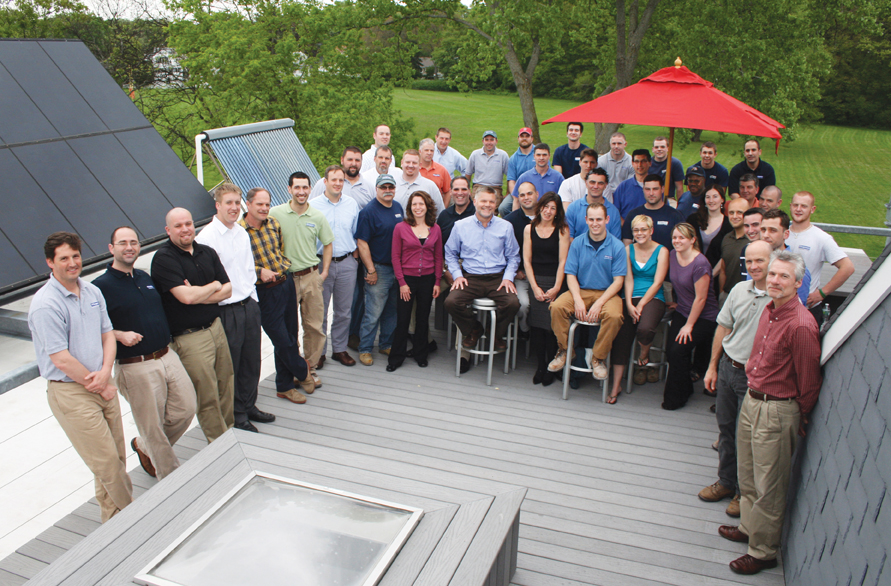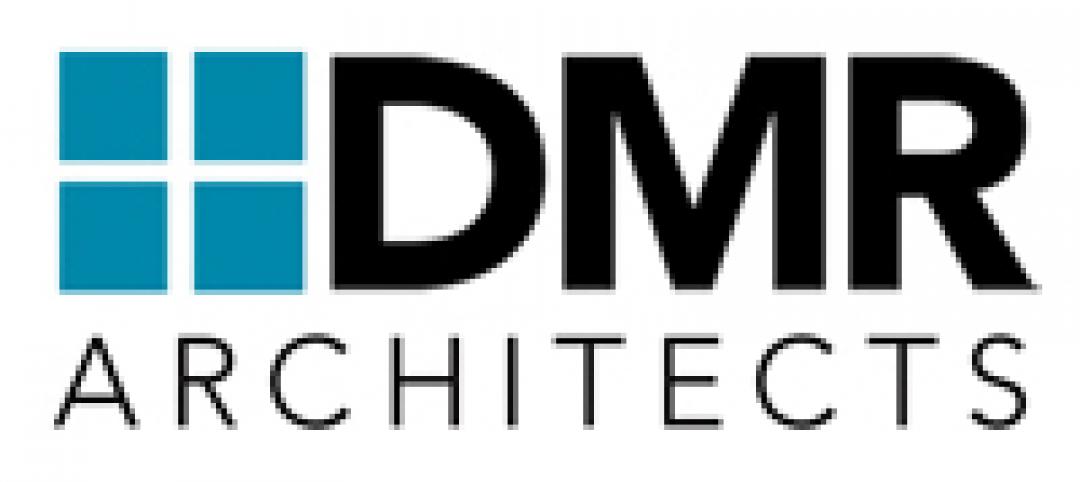Inspiration. It can occur in the strangest of places and often when it’s least expected. For John C. Hall, the 55-year-old CEO of Chapman Construction/Design, Newton, Mass., inspiration struck him atop a ladder, nearly 30 years ago.
In 1982, his business, then known as John C. Hall Construction, was purely a means for Hall to pay living expenses and tuition as he studied for his BArch in the night program at what is now the Boston Architectural College. Ultimately, his goal was to grow the company into a successful design-build firm that specialized in sustainable construction.
“I remember being up on a ladder that day and thinking that if I ever grew this company in the way I envisioned, I wouldn’t want it to be directly associated with me by name,” says Hall.
By 1984, Hall’s ladder-top inspiration had come to fruition as Chapman Construction/Design, which is based on Hall’s middle name. Nearly 28 years later, the company has grown to more than 50 employees and completed hundreds of construction projects. More to the point, Chapman has become one of the nation’s leading sustainable construction firms, which is one of many reasons why Building Design+Construction has recognized Chapman as a “Best AEC Firm to Work For.”
Sampling Chapman’s benefits
- $250 annual allowance for work clothing for all employees
- $500 annual tool allowance for field staff
- The Battle Buddy mentor program, in which a senior staffer is assigned to a younger field-based employee to offer personal guidance and professional development
- Vehicle reimbursement and priority parking at the Chapman offices for employees using hybrid vehicles
- “Personal Growth Sabbatical” for employees who have been at the company more than 10 years—some have used this time for volunteer work in Africa and Hawaii.
More than half of Chapman’s 55 employees have been with the company for more than 10 years.
COMMITTED TO SUSTAINABLE CONSTRUCTION PRACTICES
In the early years, Chapman grew its client base by word of mouth, repeat business, and a reputation for excellence. Hall wanted the business to grow by pursuing the kind of projects that fit the business model. He took a pass on opportunities for growth that were simply for the sake of growth.
In the intervening years, the company has built a solid client base: 70% of the firm’s work consists of commercial interior work for corporate, educational, and medical/biotech clients; 20% supports area nonprofit organizations and institutional clients; and the remaining 10% involves consulting clients in the LEED rating system, building performance, and renewable energy.
Led by Hall and vice presidents John Ferreira, Bob D’Amico, and Rich Elliott, the firm’s 55 employees, from the president to site supervisors to office staff, are committed to implementing the most advanced environmental sustainable construction practices in the AEC industry. Operating under a team approach is a philosophy that Hall says guides the firm’s dedication to sustainability at all stages of the construction process. “Sustainability isn’t something you can just dabble in,” says Richard Elliott, a Chapman vice president. “To be successful, it has to become a mindset that everyone on the team shares. We’re lucky to have a staff here that not only understands that but is enthusiastic about it, making sustainability part of everything we do.”
In 2009 Chapman renovated its own two-story, 17,000-sf headquarters, which received the U.S. Green Building Council’s LEED-CI Platinum rating. “We use the building as a teaching tool with our clients and other industry partners, as well as students and the local community,” says Hall.
INTEGRATING PROFESSIONAL GROWTH, DEDICATION, AND DEVELOPMENT
An integral part of Chapman’s success has been the professional development and continuing education of employees. The firm provides quarterly industry-specific seminars on building science, innovative methods and materials, and LEED training.
“The dedication of our employees and our companywide commitment to sustainability has been a major differentiator from the competition,” says Hall.
Currently, 26 of the 55 Chapman staff members have earned LEED accreditation.
“It’s an exciting, progressive place to work with a close-knit culture,” says Hall. Every Chapman employee has the opportunity for personal and professional growth. Chapman’s key business ideas and initiatives are driven by nine Working Groups and focus on:
- Building Science and Education
- Client Relations
- Corporate Management
- Field Operations and Safety
- Human Resources
- Marketing
- Project Management Process
- Subcontractor Development
- Technology
The Working Groups, which range in size from five to 10 members, consist of a diverse cross section of staff, including senior management, field staff, and new employees. The goal is to encourage the employees’ sense of ownership so they can see their ideas develop from conception to implementation.
“The Working Groups have been a win-win for Chapman and its employees,” says John Ferreira, senior vice president of construction. “The groups provide a venue for everyone to share ideas, and the company benefits from having so many people thinking about how to improve our business, whether by streamlining an existing process or developing a new program.”
It is from these Working Groups that many of the employee benefit programs have evolved.
SUBCONTRACTORS SUBJECTED TO CHAPMAN’S STANDARDS
Chapman’s relationship with its subcontractors is providing positive results on the job site. “An increasing number of clients are seeing the value in having a construction manager involved early in the process, as well as the benefits of transparency and true collaboration among the team members,” says Hall.
Click here to see a video on Chapman’s clients appreciate the firm’s team-first approach.
In order to work for Chapman, subcontractors are subject to a detailed application process. Subcontractors that exceed Chapman’s expectations qualify for inclusion in Chapman’s Subcontractor Phonebook, which currently lists more than 2,000 subs.
Once the job is completed, Chapman puts the subcontractors through a rigorous review and evaluation. The goal is two-fold: first, to give Chapman’s project managers detailed information on the subcontractors for reference on future contracts; and, second, to provide the subs critical information they can use to operate their companies more efficiently.
“We have many dedicated and respected subs that we work with again and again,” says Hall. “We even have a Working Groupfocused entirely on our relationships with our subs, constantly evaluating them and providing constructive feedback.”
The Subcontractor Phonebook record so far: less than 1% turnover, and many subcontractors have been used repeatedly.
CHAPMAN’S OFFICE
a showcase of sustainable strategiesIn 2010, Chapman Construction/Design self-performed the LEED-CI Platinum renovation of its two-story, 17,000-sf headquarters in Newton, Mass.—at the time, only the third LEED Platinum project in Massachusetts. Chapman CEO John Hall envisioned the office reconstruction as a showcase of cost-effective sustainable strategies that the firm uses to educate clients and partners.
Guy Compagnone, Chapman’s director of sustainable practices, says implementing green strategies in the firm’s own offices gives Chapman the opportunity to show clients a wide range of products. “It gives them a real sense of how different strategies might work in their own spaces, and it allows us to zero in on the most practical and cost-effective measures,” he says.
A 47-kW photovoltaic system satisfies more than 90% of the company’s electrical demands. Other factors contributing to the LEED Platinum status:
- Improved building envelope
- Window filming to reduce cooling load
- Overhanging solar array that doubles as a shade awning, cutting solar heat gain
- White roof with vegetated sections to reduce cooling load
- Gas-powered furnace and high-efficiency condenser to replace inefficient HVAC system
- Solar thermal system that provides domestic hot water
- Tubular skylights to increase daylighting
- High-efficiency plumbing and lighting fixtures to reduce water and energy consumption
They cut the number of light fixtures by 40%. The remaining fixtures were replaced with high-efficiency lamps and ballasts, bringing the office lighting load to 35% below ASHRAE standards. Water consumption has been reduced to 60% below ASHRAE standards.
Chapman estimates the firm is saving as much as $20,000 a year on electricity. The total retrofit investment is expected to be paid back within five years.
The Massachusetts Department of Energy Resources has recognized Chapman’s office building as the first near-net-zero commercial building in the Commonwealth.
WORKING FOR CHAPMAN ON THE JOB SITE
For every project, Chapman recommends sustainable alternatives to meet or exceed LEED standards. Chapman selects and utilizes materials that are high in recycled content, including drywall and acoustic ceiling tiles. Specified paints, sealants, and adhesives contain low or no volatile organic compounds. Chapman also explores every avenue and opportunity for rebates, grants, and tax incentives associated with efficiency upgrades incorporated into the work.
Safety is of critical importance to Chapman. The firm recently submitted its Work-Related Injuries and Illnesses summary to OSHA on the heels of more than 117,000 man-hours in 2011. “We had zero recordable incidents or illnesses for the year,” says Hall. “We attribute this success to our comprehensive safety program and our outstanding employees, who go above and beyond to ensure that safety is the top priority on all job sites.”
CHAPMAN AWAY FROM THE OFFICE
Life outside the office is important to Chapman employees. The close-knit Chapman employees spend time together away from the office several times a year for team building and social activities.
An employee favorite is the Bill Rich Memorial Challenge. The annual summer fishing trip and picnic honors the late Bill Rich, a much-loved Chapman supervisor who passed away in 2009. Other team-building events include the “Ode to Summer” cookout every September at the Chapman offices.
Chapman is also dedicated to supporting the next generation of engineers and construction professionals. The firm awards a $2,000 annual scholarship to a student at Boston’s Wentworth Institute of Technology and the Minuteman Career & Technical High School, Lexington, Mass.
“Our partnership with Chapman is truly a model for collaboration between higher education and industry,” says Wentworth president Dr. Zorica Pantic. “The Chapman Construction/Design Sustainability Scholarship Program will make a difference in the lives of students and help to further the studies of sustainability.”
CONSTRUCTION INDUSTRY REACHING FOR THE NEXT RUNG
As for the future of the construction industry, Hall says he believes it will progress well beyond the sustainable practices currently employed by the industry. “I think we’re already seeing that green thinking and sustainable practices are becoming more and more expected,” says Hall. “Over the next decade, they will become standard practice, and new approaches and technologies are going to make construction exponentially more efficient than it is today.” +
Related Stories
| Nov 8, 2011
$11 million business incubator Florida Innovation Hub at the University of Florida completed by Charles Perry Partners, Inc.
The facility houses the UF Office of Technology Licensing, UF Tech Connect, other entities, and more than 30 startup technology tenants.
| Nov 8, 2011
Designer joins Holabird & Root
Clifton has been awarded numerous awards throughout her career, including two AIA Chicago Design Excellence Awards.
| Nov 4, 2011
Mortenson Construction builds its fifth wind facility In Illinois
Shady Oaks Wind Farm is under construction near Compton, Ill.
| Nov 4, 2011
CSI and ICC Evaluation Service agree to reference GreenFormat in ICC-ES Environmental Reports?
ICC-ES currently references CSI's MasterFormat and other formats in all of its evaluation reports. The MOU will add GreenFormat references.
| Nov 4, 2011
McCarthy completes construction of South Region High School No. 2 in Los Angeles
Despite rain delays and scope changes, the $96.7 million high school was completed nearly two-months ahead of schedule.
| Nov 4, 2011
Two Thornton Tomasetti projects win NCSEA’s 2011 Excellence in Structural Engineering Awards
Altra Sede Regione Lombardia and Bank of Oklahoma Center both recognized.
| Nov 3, 2011
GREC Architects announces opening of the Westin Abu Dhabi Golf Resort and Spa
The hotel was designed by GREC and an international team of consultants to enhance the offerings of the Abu Dhabi Golf Club without imposing upon the dramatic landscapes of the elite golf course.
| Nov 3, 2011
Hardin Construction tops out Orlando Embassy Suites
The project began in April 2011 and is expected to open in fall 2012.
| Nov 3, 2011
2012 Pritzker Architecture Prize Ceremony to be held in China
The tradition of moving the event to world sites of architectural significance was established to emphasize that the prize is international, the laureates having been chosen from 16 different nations to date.
| Nov 3, 2011
DMR Architects welcomes two new staff members
Siro Gonzalez joins the staff as junior graduate architect and Megan Byers joins the staff as marketing assistant.
















